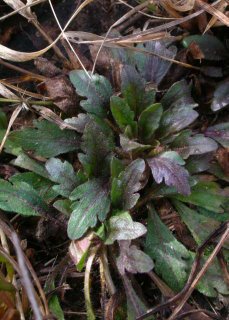 What’s blooming outside: Nothing. Someone in the village pruned his fruit trees; two men down the road were clearing weeds Saturday.
What’s blooming outside: Nothing. Someone in the village pruned his fruit trees; two men down the road were clearing weeds Saturday.What’s blooming inside: Aptenia, zonal geranium.
What’s green and visible in the area: Honeysuckle; needle grass and other unidentified grasses; agave, yucca, yew, juniper, arborvitae, piñon and other pines.
What’s green in my yard: Columbine, rose stems, sweet peas, thrift, rockrose, yellow evening primrose, vinca, tansy, coreopsis, Mount Atlas daisy, horseweed.
What’s gray: Snow-in-summer, pinks, buddleia, Greek yarrow, golden hairy aster, four-winged salt bush.
What’s red: Coral bells, pinks, small flowered soapwort, cholla; white, coral and blue beardtongues.
Animal sightings: More gopher mounds, especially near tree roots.
Weather: By Wednesday, snow was gone from open fields, but survived on walks, drives, and north and west sides of buildings and fences. Ground frozen.
Weekly update: Horseweed is a weed, plain and simple.
Farmers hate it. Seed can sprout anytime after it drops, and it starts blooming here in June. A single plant can produce 200,000 wind-borne achenes and 80% of those can germinate. 91% of those that emerge in the fall survive winter as rough textured basal rosettes. More break ground when temperatures rise in the spring.
Worse, roots release chemicals that inhibit corn growth. Roundup Ready soybean, corn and cotton seeds were released in 1996 and 1997. Farmers tilled their land less often to uproot weeds. Conyza Canadensis plants that resisted the active agent, glyphosate, were reported in 2000, and Darwinian selection has prevailed.
In my yard, the annual’s not particularly noxious, just gawky. The stalks grow anywhere from 1' to 6' high, but the white composite flowers are no more that 1/4" high and never fully open. The fluorescence is so private it might never occur, except for the puffball seed heads.
Horseweed has no nasty thorns or harpooning seeds, and isn’t particularly difficult to pull when the ground is wet in July. The roots don’t usually break and regenerate like dandelions. The taproots are long, but aren’t nearly as entrenched as those of sweet clover.
When I remove them, they release a lemon smell that hints the plant might be good for something. Indeed, limonene from leaves grown commercially in Michigan is used to flavor candy and soft drinks.
Even so, here in the southwest, this North American native has been ignored more than used, perhaps because the leaves are so bitter not even a rabbit will eat them in winter.
The Zuni dried flowers to induce sneezing for sinus and nasal problems. The Ramah and Kayenta Navajo used the stalk or leaves in a lotion for acne. The Kayenta of Arizona also tried hot poultices for prenatal infant infections and earaches, and essayed the plant for stomachaches. The Ramah of McKinley County prescribed a cold infusion for snakebite.
Young Spanish girls in the rio arriba soaked pazotillo leaves in water to lighten their complexions. They probably theorized the aroma of limonene signified it would bleach like the acids in lemons do.
It was the eclectic physicians who determined the tannin that causes the bitterness could staunch bleeding. In 1898, gynecologist Finney Ellingwood recommended an oil made from cinnamon bark, Erigeron Canadensis, as it was then called, and grain alcohol for heavy menses and bleeding from abortions. Scientists have since established that tannin is a polyphenol that binds with proteins to produce clotting.
Such utility does not negate Horseweed’s ugliness. I sympathize with farmers whenever I yank plants or cut stalks. Then I smell the lemon and wonder why someone somewhere isn’t investigating how this insignificant composite can withstand the full chemical force of Monsanto and what that biological mechanism might suggest about disease, survival, and life itself.
Notes:
Curtin, L. S. Healing Herbs of the Upper Rio Grande, 1947, republished by Western Edge Press of Santa Fe in 1997 with notes by Michael Moore.
Ellingwood, Finley. The American Materia Medica, Therapeutics and Pharmacognosy, 1919, Hebriette Kress's copy available on-line.
Shaukat, S. Shahid, Nadia Munir and Imran A. Siddiqui. “Allelopathic Responses of Conyza candinsis L.(Cronquist): A Cosmopolitan Weed,” Asian Journal of Plant Sciences 2:1034-1039:2003.
Stevenson, Matilda Coxe. Ethnobotany of the Zuni Indians, 1915.
Vestal, Paul A. The Ethnobotany of the Ramah Navaho, 1952, cited in the Native American Ethnobotany database.
Wyman, Leland C. and Stuart K. Harris. The Ethnobotany of the Kayenta Navaho. 1951, cited in the Native American Ethnobotany database.
Picture: Horseweed growing under a rugosa rose, 21 January 2007.
No comments:
Post a Comment